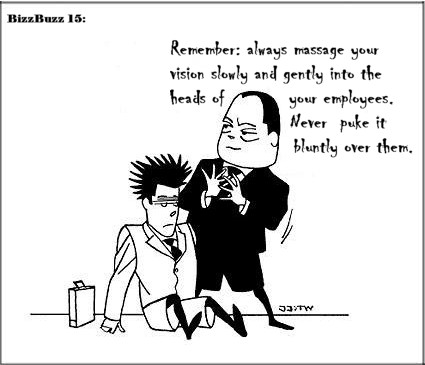|
|
|
Friday, December 7th, 2012
A Friday series exploring Startups and the people who make them go. Read all If the Shoe Fits posts here
 I confess; I don’t do Facebook or Twitter, but I do watch TV at night when I’m doing stuff that doesn’t require full focus. I confess; I don’t do Facebook or Twitter, but I do watch TV at night when I’m doing stuff that doesn’t require full focus.
I watch enough to detest the lack of creativity in most ads, but I save my greatest antipathy for the drug ads.
Mostly because the images are in such opposition to the warnings.
Cymbalta (anti-depressant) is a great example.
It is being sold as a pain reliever for people with arthritis and uses the tag line, “Imagine you with less pain.”
All I can think when they say that is, “Imagine you with all the side effects.”
The ads focus on best case analysis and only list possible side-effects because the law forces them to.
There is no real risk analysis; the good outcomes are used as cover for the downside.
This works because most of us prefer to focus on the positive.
In a 2008 column about entrepreneurs and risk Bill Buxton said, “The most dangerous way of all to play it is so-called safe. Safe leads to atrophy and certain death—of spirit, culture, and enterprise. There is not a single institution of merit or worthy of respect in our society that was not created out of risk. Risk is not only not to be avoided, it is to be embraced—for survival.”
That hasn’t changed, but there is smart risk and there is dumb risk and you need to know the difference sans dogmatic belief in your vision and rationalization.
The best way to evaluate risk, whether of a drug, promotion, romantic offer, etc., is to give equal thought to three things.
- Best case: what positives do I expect from this action? (no pain)
- Worst case: what negatives do I need to consider? (side effects)
- If the results of number 2 can be handled go forward; if not revise the action.
The problem is not risk; risk is good, as well as necessary, for you or any entity that wants to move forward.
But ‘good’ requires balanced evaluation of the best and the worst.
Option Sanity™ neutralizes excessive ISO allocation risk.
Come visit Option Sanity for an easy-to-understand, simple-to-implement stock allocation system. It’s so easy a CEO can do it.
Warning.
Do not attempt to use Option Sanity™ without a strong commitment to business planning, financial controls, honesty, ethics, and “doing the right thing.”
Use only as directed.
Users of Option Sanity may experience sudden increases in team cohesion and worker satisfaction. In cases where team productivity, retention and company success is greater than typical, expect media interest and invitations as keynote speaker.
Flickr image credit: HikingArtist
Posted in If the Shoe Fits | No Comments »
Friday, November 9th, 2012
A Friday series exploring Startups and the people who make them go. Read all If the Shoe Fits posts here
 Last Friday I cited research from Northwestern and advice from John O’Farrell of Andreessen Horowitz on the dangers of flattery and importance of not hiring ‘yes-people’. Last Friday I cited research from Northwestern and advice from John O’Farrell of Andreessen Horowitz on the dangers of flattery and importance of not hiring ‘yes-people’.
I received a couple of emails arguing that it was important in a startup that everyone in a startup was on board with the founder’s vision. Boat-rockers were not welcome; 100% agreement was needed to support the level of commitment required to succeed and without it the company was likely to founder if not fail outright.
Perhaps these folks will listen to Steve Blank.
“Countries that stifle dissent while attempting to encourage entrepreneurship will end up at a competitive disadvantage. (…) Because without dissent there is no creativity.”
Companies are small countries.
Whether it’s Google or the newest startup on the block, each has its own peculiar culture, mores and MAP.
Its own laws, spoken or not, and law enforcement; its own ways of keeping its citizens in line.
It’s your responsibility as founder to encourage dissent—especially when it’s dissenting from you.
Option Sanity™ celebrates creativity.
Come visit Option Sanity for an easy-to-understand, simple-to-implement stock allocation system. It’s so easy a CEO can do it.
Warning.
Do not attempt to use Option Sanity™ without a strong commitment to business planning, financial controls, honesty, ethics, and “doing the right thing.”
Use only as directed.
Users of Option Sanity may experience sudden increases in team cohesion and worker satisfaction. In cases where team productivity, retention and company success is greater than typical, expect media interest and invitations as keynote speaker.
Flickr image credit: HikingArtist
Posted in Culture, Entrepreneurs, If the Shoe Fits | No Comments »
Thursday, June 28th, 2012

You founded your company on a vision; a vision of how your product/service would change the world.
Your vision attracted people; people who can turn your vision into reality.
If that doesn’t happen it’s on you.
If you share, explain and clarify your vision, listen to input from all sources as you refine it and keep it flexible you’ll be a long way to succeeding.
But if you proclaim your vision, hoard the details and adhere to it come what may you’ll shoot yourself (and your investors) in the foot.
SUBMIT YOUR STORY
Be the Thursday feature – Entrepreneurs: [your company name]
Share the story of your startup today.
Send it along with your contact information and I’ll be in touch.
Questions? Email or call me at 360.335.8054 Pacific time.
Image credit: darktaco
Posted in Entrepreneurs | No Comments »
Friday, May 4th, 2012
A Friday series exploring Startups and the people who make them go. Read all If the Shoe Fits posts here
 You’re a founder and you have a vision. You’re a founder and you have a vision.
You tell people about your vision with an eye to recruiting them as investors or employees or customers.
While it’s important that your vision be enticing it’s more important that it dazzle with its clarity.
Clarity is not easy, which is why elevator pitches and tag lines are so difficult to do.
Most people start with a highly embellished description and work to reduce/clarify it.
The reverse is often easier.
Start with a truly bare bones version, such as this description of a restaurant.
“We buy food. We fix it up. And we sell it at a profit.” – Celebrity Chef Mario Batali**
Then add embellishments slowly, one at a time and get feedback with each iteration.
But avoid getting all the feedback from the same audience.
Each time people hear it they add knowledge and reference, and context to their unconscious database, so in time they start interpolate and filling in the blanks just as you do.
Hence you need to constantly refresh your audience to achieve viable feedback, but that unconscious database is the bane of working with anything over the long haul,
The point of all this is to remind you to clarify your vision before you start to sell it.
Option Sanity™ is plain-spoken and direct.
Come visit Option Sanity for an easy-to-understand, simple-to-implement stock allocation system. It’s so easy a CEO can do it.
Warning.
Do not attempt to use Option Sanity™ without a strong commitment to business planning, financial controls, honesty, ethics, and “doing the right thing.”
Use only as directed.
Users of Option Sanity may experience sudden increases in team cohesion and worker satisfaction. In cases where team productivity, retention and company success is greater than typical, expect media interest and invitations as keynote speaker.
**Hat tip to Wally Bock for the Mario Batali quote.
Flickr image credit: HikingArtist
Posted in Entrepreneurs, If the Shoe Fits | 2 Comments »
Friday, March 2nd, 2012
A Friday series exploring Startups and the people who make them go. Read all If the Shoe Fits posts here
 Over the past few days we’ve been discussing the importance of disconnecting, the destructive force of 24/7 work and what drives people to do it. Over the past few days we’ve been discussing the importance of disconnecting, the destructive force of 24/7 work and what drives people to do it.
People who found companies do so because they have a vision; they recognize a need as well as a way to fill it.
The real work comes between recognition and fulfillment—sharing and evangelizing the vision, building a framework within which the vision can become reality and then sharing the reality with the world at large.
The middle step, the framework, is what differentiates short-term success from long-term.
The middle step requires a cultural vision that also needs to be shared and evangelized.
There is much truth in the analogy that startups are like children and, like parents, founders need to decide ahead of time the value system they want their child to absorb.
“People feel this constant need to be connected. There’s no priority structure. Everything is urgent. Everything is red flagged.” Nancy Rothbard, a Wharton management professor
As founder you have a far-reaching choice to make; far-reaching because it will affect your company for years to come and determine if your child is
- respectful and values the people in and around it; or
- a spoiled brat that sees the world only in terms of mememememememe.
Option Sanity™ is values-based.
Come visit Option Sanity for an easy-to-understand, simple-to-implement stock process; so easy a CEO can do it.
Warning.
Do not attempt to use Option Sanity™ without a strong commitment to business planning, financial controls, honesty, ethics, and “doing the right thing.”
Use only as directed.
Users of Option Sanity may experience sudden increases in team cohesion and worker satisfaction. In cases where team productivity, retention and company success is greater than typical, expect media interest and invitations as keynote speaker.
Flickr image credit: HikingArtist
Posted in Culture, Entrepreneurs, If the Shoe Fits | No Comments »
Friday, February 24th, 2012
A Friday series exploring Startups and the people who make them go. Read all If the Shoe Fits posts here
 I rarely get comments, but I do receive emails; usually with questions that are too sensitive to ask publicly. I rarely get comments, but I do receive emails; usually with questions that are too sensitive to ask publicly.
Very occasionally over the years they are commentary on what I wrote; I guess the writers assume the language used would relegate them to spam, so they email me directly.
I don’t mind, because it’s kind of cool to know my ideas can generate such explosive reactions, although sometimes I wonder why the person even reads MAPping Company Success.
I received such a response to yesterday’s post.
“James” made no bones that he doesn’t think much of my MAP concept, but his main disagreement was with the final sentence, which he said was garbage, especially in a startup.
Because just as their suggestions won’t directly change your MAP, your suggestions won’t directly change theirs [customers, employees and vendors].
James told me that
- his people followed his lead and his vision;
- running a startup was already an 80 hour-a-week job without spending additional time coddling misfits;
- he paid his vendors on time and if they didn’t cooperate he would find new ones; and
- customers wanted a quality product that did what they needed done at a price they were willing to pay and anything else was marketing hype.
I wrote back saying that everybody was entitled to their own opinion and I appreciated his taking time to share his with me.
So tell me, do you agree with James? With me? Or are you somewhere in-between?
Option Sanity™ acts as a screening tool.
Come visit Option Sanity for an easy-to-understand, simple-to-implement stock allocation process. So easy a CEO can do it.
Warning.
Do not attempt to use Option Sanity™ without a strong commitment to business planning, financial controls, honesty, ethics, and “doing the right thing.” Use only as directed.
Users of Option Sanity may experience sudden increases in team cohesion and worker satisfaction. In cases where team productivity, retention and company success is greater than typical, expect media interest and invitations as keynote speaker.
Flickr image credit: HikingArtist
Posted in Culture, Entrepreneurs, If the Shoe Fits | No Comments »
Sunday, January 8th, 2012
I haven’t found anyone who wants to do a Sunday comic yet; if you know someone please have him/her contact me ASAP. In the meantime…

Flickr inage credit: maurice.heuts
Posted in Just For Fun | No Comments »
Thursday, December 15th, 2011
 You started with nothing more than an idea. You started with nothing more than an idea.
Your idea became a vision and your vision a business plan.
You built a great team and infused them with passion.
You found skilled advisors and investors who believed.
You built your product.
Your company launched it with panache.
The media loved it.
But sales were dismal.
No matter what you and your team did you couldn’t gain traction.
You laid off your team
You were left with one question: what did you do wrong?
The answer is ‘nothing’.
What went (or will) go wrong is clearly explained in this article by Henry Blodget. And be sure to read successful entrepreneur and VC Nick Hanauer’s commentary on taxing the rich and one more that explains why entrepreneurs like Steve Jobs do not create jobs—their customers do.
You did everything right, but no matter how great the product, food, heat and a roof overhead come first.
Disclaimer: I realize this post will come over as partisan and liberal to some of you and I sincerely hope you will share your disagreement in the name of healthy discussion.
Flickr image credit: Charles Kremenak
Posted in Entrepreneurs | No Comments »
Thursday, September 29th, 2011
 A comment in response to an article entitled Steve Jobs Is a Lousy Role Model caught my eye. A comment in response to an article entitled Steve Jobs Is a Lousy Role Model caught my eye.
I agree that good managers have to ‘manage’ their employees emotional well-being but I believe visionary leaders have to execute on their vision… Don’t get confused that good managers can build an innovation company without effective leaders to lead the charge.
Jobs ability to see around corners product-wise is unique, but that skill doesn’t make him a leader; it makes him a product visionary.
Yes, he is brilliant; yes he has charisma; yes, he screws up and the combination proves he’s human.
What needs to be understood is that Jobs successes don’t excuse his bad actions.
Do yourself a favor and recognize that your vision can also be your own personal Kool-Aid.
Richard Branson is also a visionary and successful entrepreneur, but his approach is a world away from Jobs.
The trick to finding a role model is to eliminate the singular, find multiple models and emulate their best traits after tweaking them to fit your own MAP and situation.
Last year I wrote, People love to quote the adage “there is no “I” in team” when somebody’s ego gets out of hand; perhaps a new adage is needed that states “there is no “I” in leader.” Of course, someone will argue that there is an ‘i’ in leadership, which is true, but when ‘i’ becomes ‘I’ it changes leadership to leadershit.
Even Steve Jobs phenomenal success provides no reason to change my mind.
Image credit: Wikimedia Commons
Posted in Entrepreneurs, Leadership | 11 Comments »
Friday, January 28th, 2011

There is a wonderful post by Kent Lineback at HBR called The Leadership Learning Moment That Wasn’t. In it he tells of blowing a great opportunity because he couldn’t get the other executives in the company to buy into his vision.
“What do you think is going on? I made an important point and everybody yawned and moved on.”
“It was an important point,” he [the consultant] said, “but you didn’t build any bridges.”
Lineback goes on to say that he thought long and hard about the consultant’s words and realized he was right.
“I didn’t build bridges. I didn’t reach out and connect with others on their terms. I talked at them. I had a solution, a beautiful vision. I knew the answer, and I spent my time telling everyone what it was and what the company had to do.
But that didn’t change anything.
I knew he was right. I knew I should do what he said. But I couldn’t debase my perfect vision by turning it into a free-for-all idea jam. Better to stay pure and fall on my sword, a martyr.”
That is one of the great problems of leadership visions, they are the property of one person; one person who will do almost anything to sell the vision—anything except share and modify it.
Leadership visions happen at all levels of a company from the CEO down to the newest supervisor.
It’s a side effect of drinking the leadership Kool-Aid, so you might want to think twice before indulging your thirst.
Image credit: http://www.flickr.com/photos/khurt/5252851284/
Posted in Leadership | No Comments »
|
 Subscribe to
Subscribe to
MAPping Company Success
About Miki 
Clarify your exec summary, website, etc.
Have a quick question or just want to chat? Feel free to write or call me at 360.335.8054
The 12 Ingredients of a Fillable Req
CheatSheet for InterviewERS
CheatSheet for InterviewEEs™
Give your mind a rest. Here are 4 quick ways to get rid of kinks, break a logjam or juice your creativity!
Creative mousing
Bubblewrap!
Animal innovation
Brain teaser
The latest disaster is here at home; donate to the East Coast recovery efforts now!
Text REDCROSS to 90999 to make a $10 donation or call 00.733.2767. $10 really really does make a difference and you'll never miss it.
And always donate what you can whenever you can
The following accept cash and in-kind donations: Doctors Without Borders, UNICEF, Red Cross, World Food Program, Save the Children
*/
?>About Miki
About KG
Clarify your exec summary, website, marketing collateral, etc.
Have a question or just want to chat @ no cost? Feel free to write
Download useful assistance now.
Entrepreneurs face difficulties that are hard for most people to imagine, let alone understand. You can find anonymous help and connections that do understand at 7 cups of tea.
Crises never end.
$10 really does make a difference and you’ll never miss it,
while $10 a month has exponential power.
Always donate what you can whenever you can.
The following accept cash and in-kind donations:
|
 I confess; I don’t do Facebook or Twitter, but I do watch TV at night when I’m doing stuff that doesn’t require full focus.
I confess; I don’t do Facebook or Twitter, but I do watch TV at night when I’m doing stuff that doesn’t require full focus.





 You started with nothing more than an idea.
You started with nothing more than an idea. A comment in response to an article entitled
A comment in response to an article entitled 

